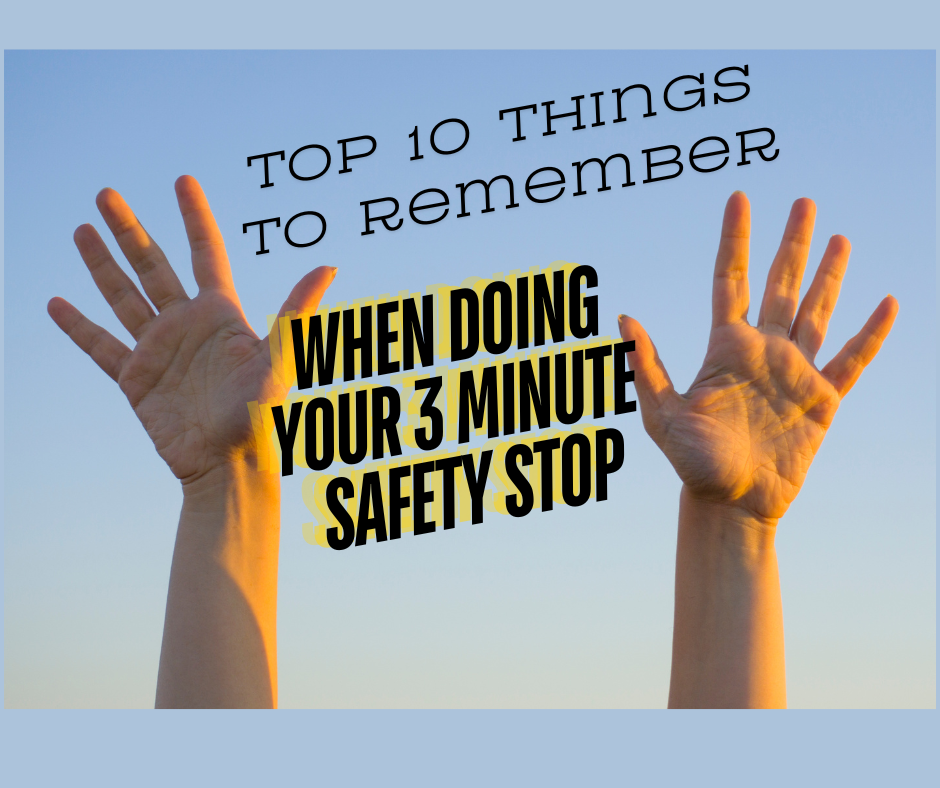Safety stops are a recommended procedure at the end of every dive to allow some extra dissolved gases to escape your tissues before exiting the water completely. It is done at 15 feet and it is a must to complete it at 3 minutes or over.
1. Hand Signals for 3 minute safety stop
The 3 minute safety stop

Deploying a DSMB
which looks like you’re throwing a ball in the air.
Air assessment

Communicate how much time you have left to your buddy using basic numbers, gesturing to your computer for the number of minutes remaining.


Signal the end of the safety stop
When it’s all clear, brush your computer upwards.
2.Buoyancy
At the end of the dive, you are most buoyant in shallow water. The shift in your buoyancy is greatest because the air in your BCD and drysuit changes volume significantly. Your cylinder is nearly empty and more buoyant.
Pay attention to your buoyancy as you ascend to your stop depth and keep your hand on your deflate button to prevent a runaway ascent. Make your left shoulder the highest point underwater so that any air can escape near your inflator hose or drysuit dump valve.
Not really recommended but for worse case scenario of impossible positive buoyancy, use a reef hook.

But make sure to choose a noninvasive spot to hook your hook. You need to finish the 3 minutes no matter how positively buoyant you are, and the hook is the best way to anchor yourself at 15 feet, then use it.
Just continuously fin down as much as you could if 3 minute safety stop is done in blue open water. Yes, unfortunate to be in this situation, but it is most crucial to release as much of that nitrogen and or other dissolved gases as you much as you can.
Just make sure you are fully deflated to compensate and fin down if all else fails.
3.enjoy it
Many divers switch off during a safety stop, spending three minutes looking at their computer screen. Instead, keep looking around or plan your safety stop to explore the reef at a shallow depth. If there’s nothing to look at, play tic-tac-toe or rock-paper-scissors with your buddy. Some divers practice their bubble rings, but remember, you’re still scuba diving.
4.stay on trim stay horizontal

Safety stops are best done when you’re completely horizontal in the water, ensuring your entire body is at the same depth and decompressing at the same rate. If you’re holding onto a line in a current, there’s more space for other divers to be at the correct depth. Use this time to practice your position in the water and work on your trim for the next dive.
5.plan your position on the water
Consider where you are in the water and where you plan to exit. It’s more convenient to surface near your exit point than to have a long surface swim. Think about your exit strategy during the safety stop. If a boat is picking you up,

swim away from the reef to give them space to pick you up, avoiding the risk of the boat being dragged over rocks.
6. dsmb or smb
If you’re swimming out into open water, a Surface Marker Buoy is essential to alert boat traffic.
Deploying a DSMB becomes easier with practice. Keep the line taut to avoid tangling both when deploying the buoy and when winding it in.
Plan ahead by Marking the line at the 5m point as a visual depth marker on your dsmb line to ensure you maintain the correct depth.

7. Hold tight but rope burn and shoulder dislocation in mind
If you’re holding onto a line attached to a boat, don’t hold it too tightly as it can yank you around, which can be dangerous. If the rope pulls, let it go. Be cautious with ropes as they can be covered in sharp mollusks, and the rope itself can be coarse and cause injuries.
8. do skills but do not overdo
Avoid practicing certain skills during your safety stop. You are still decompressing, so avoid activities that could lead to panic or rapid ascent. After your computer gives you the all-clear, ascend slowly. Use the deflate button and exhale to control your ascent, keeping your spool line taut to avoid loose line entanglements.
9. prepare and include the safety stop in your dive plan
Include the safety stop in your dive plan and gas management. Safety stops are a buffer to allow more dissolved gas to escape from your tissues, bloodstream, and lungs. Don’t wait until your gauges are in the red zone to ascend. Plan to end the dive with 50bar in your cylinder, not just starting your safety stop. This extra gas is crucial in emergencies.
- Stop, Look, & Listen
10. stop look listen
While ascending after your safety stop, turn around, look, and listen to the surface. A surface marker buoy doesn’t guarantee safety. Not all boat owners are observant. Look for boat traffic and be prepared to stop your ascent to avoid collisions. You will hear a boat first but need to look around to identify its direction and avoid it.

